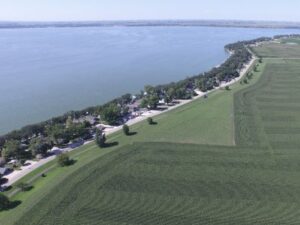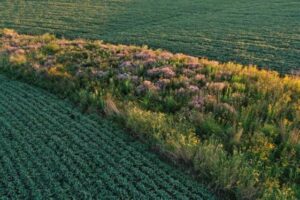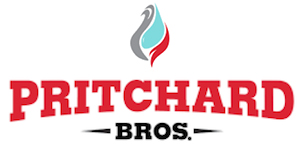AMES, Iowa—With farmland that adjoins one of Iowa’s largest and most popular recreational lakes, Eric Hoien wanted to make sure he was doing his part to keep farm nutrients in his field, while maintaining a pleasant landscape for the public.The solution that he found, after reading an article in the Des Moines Register, was to plant “Prairie Strips” along the edge of his field and the roadway adjoining Spirit Lake.Formally known as Prairie STRIPS (Science-based Trials of Rowcrops Integrated with Prairie Strips,” these narrow bands of 30-120 foot wide prairie are a federally recognized conservation practice that has shown significant benefits for water quality improvement, wildlife conservation, pollinator habitat and aesthetic beauty.In 2015, Hoien installed prairie strips on 24 acres of his 129-acre farm that adjoins the lake, working with the Natural Resources Conservation Service and the Conservation Reserve Program. Today, his prairie strips are fully developed, with stands of perennial wildflowers and grasses that filter runoff, keep nutrients and sediments in place, and provide an ideal habitat for birds and other wildlife.“The strips are a way of combining conservation with farming,” said Hoien, who rents his land to a local farmer. “They don’t require taking a whole field out of production, as would some other conservation programs. Moving forward for Iowa and the Midwest, I think it’s important to have practices that promote both conservation and farming.”About the same time that he installed the strips, Hoien was vacationing with some friends in Mexico and flew over the Gulf, where he saw the effects of the dead zone.“It was like this huge mud puddle. I could see it plain as day,” said Hoien. “It made me realize there’s a lot of Midwest soil that has come down through the watershed over the years, and that we need to do more to keep it in our fields.”Paul Mugge, an organic farmer from O’Brien County, installed Prairie Strips on his farm about 23 years ago, about eight years before researchers at Iowa State University began to study them as part of a defined research project.His goal, at the time, was to provide a barrier to the pollen from neighboring farms that were not organic. He quickly found that the strips did much more than stop pollen. They also stopped erosion and nutrient loss, improved the clarity of water leaving his farm, and provided wildlife habitat and a place for people to take photos on an Iowa prairie.“They have been very effective at controlling erosion, I would say just as effective as terraces,” said Mugge. “I’ve seen a noticeable increase in beneficial insects that I rely on as an organic farmer, and the strips simply look good. I’ve had high school seniors and others who want to have their pictures taken in the strips, which tells me the public appreciates them, as well.”The Prairie Strips project started about 19 years ago, with a team of researchers and Iowa State University Extension and Outreach specialists who identified strip projects that could be implemented at the Neil Smith National Wildlife Refuge, in central Iowa.By placing the strips at the bottom of fields, where water leaves the property, researchers found at the Neal Smith National Wildlife Refuge they were able to reduce soil loss by 95%, phosphorus losses in surface runoff by 90%, nitrate concentrations in groundwater by 72% and total nitrogen losses in surface runoff by nearly 85%, compared with watersheds where only crops were grown.The strips were tested in 12 watersheds, and the results showed the ideal amount of land to put into strips, per farm, was about 10%. Landowners can put up to 25% of their acreage into prairie strips and still qualify for conservation payments.Practical solutionTim Youngquist, the Prairie Strips liaison for Iowa State, said farmers like knowing they can still farm most of their land while maintaining the strips, and that because they are true strips of 30-120 feet wide, they can be placed in the most sensitive parts of the farm, while allowing the farmer to plant most of the farm as usual.Where more water is flowing down-slope, prairie strips should be wider, and where less water is flowing down-slope, the prairie strips can be narrower.Youngquist said farmers sometimes plant the strips where point rows would otherwise exist, and places where the slope and terrain would make normal farming practices difficult. Youngquist said the federal provisions are lenient enough to allow farmers to turn equipment or drive across with equipment, to access other parts of their farm.The strips have also fared well in fields where herbicides are used, provided some common sense is applied. Youngquist said strips have proven fairly resilient to herbicide drift and the occasional issue of overspray, although like any other plant, they will die if deliberately sprayed or if the operator is not cautious.Youngquist has served as the farmer liaison since 2014.“Basically, I’m the pivot point between the researchers here at Iowa State and the farmers and landowners who are interested in developing prairie strips,” he said.Continued growthThe program has grown substantially since its inception, and has been a federally recognized conservation practice, with farm bill funding, since 2020. Today, more than 15,000 acres are in prairie strips across the U.S., with most located in the upper Midwest.Because the strips are now a federal program, farmers and landowners can work directly with the Natural Resources Conservation Service and their Farm Service Agency to learn more about installation and maintenance.In recent years, Youngquist has devoted more of his time to working with other land grant universities, helping them better understand prairie strips and offer them to their own landowners. As the popularity of the practice grows, he is hopeful more universities will implement Prairie Strips programs and research programs similar to Iowa State.“We are really excited to see how much this has expanded,” said Matt Helmers, director of the Iowa Nutrient Research Center at Iowa State. “With water quality concerns across the Midwest and most of the country, we feel the strips have real-world value almost anywhere people live and farm.”Helmers is also a professor and agricultural engineering specialist with ISU Extension and Outreach, and has partnered with other extension staff to offer field days and educational webinars about the benefits of Prairie Strips.“Prairie Strips are changing the agricultural system, but in a voluntary and incremental way,” said Youngquist, who grows corn and soybeans on his family’s farm in Sac County. “I love farming and I’m trying to improve it. I’m looking at what we can do to make our state better.”The initial program was started by a core group of Iowa State specialists that included Helmers, Lisa Schulte Moore, associate director of the Bioeconomy Institute and the STRIPS wildlife research lead, and Matt Liebman, professor of agronomy. The team has grown and become more interdisciplinary over the years and now includes more than 40 specialists, mostly from Iowa State, and a dozen graduate students.Making a differenceHelmers said a big reason for the growth is that farmers appreciate what the strips are doing for them. The soil and water conservation, wildlife habitat and the aesthetic benefits are being borne out as expected.“I think there’s a growing appreciation for prairie and the many benefits it can provide,” said Helmers. “There is conservation and aesthetic value and curiosity by the landowner as to what it will look like from year to year.”In addition to research, Prairie Strips also serve as host sites for educational field days, and as sites for other prairie strip owners to collaborate and share information.For more information on Prairie Strips, including testimonials from landowners who have implemented them, visit the Prairie Strips project website.

Prairie Strip acting as a buffer to Spirit Lake in northern Iowa (Photo credit: Aerial photo by Eric Hoien).

Prairie Strip located mid-field.

(contributed press release, ISUANR)









